Daimakaimura (Ghouls 'n Ghosts)
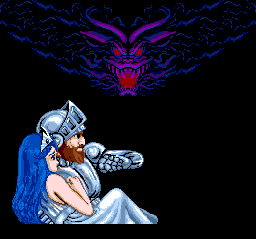
I'd long thought that when the time finally came for me to jot down some thoughts on SuperGrafx Ghouls 'N Ghosts, I'd get the standard comparisons with the Genesis version out of the way quickly and focus on what makes GNG such an awesome action-platformer to begin with. I doubt there is anyone at this point who hasn't been exposed to the typical commentary regarding the SGX card's nicer colors, superior audio quality, and higher level of difficulty. No need for me to deliver the message yet again when everyone has heard it all before.
Of course, this was before I'd even played the SGX game.
Well, I've decided to scratch that plan, as I was completely blown away by this incredible effort even though I'd owned and enjoyed the Genny GNG cart for many years (and my like for it has not waned a bit). Faded colors were replaced by brilliancy; melodies once weak were made rich and atmospheric. And the SGX rendition really is tough as hell, constructed through and through for true hard cases.
And now
that my astonishment has been noted, I can proceed with
my observations regarding the core game itself. GNG
received a lot of attention back in the day for its
gigantic bosses, particularly the Shielder (or "Statue
of Terror"), the armored cyclopean head-wielder who
guards the gateway to Area 2. He and The Legendary Axe's
Jagu were impressive overgrown representatives of the
new army of game-villain behemoths that appeared at
the dawn of the 16-bit era; but while those two giants
got most of the press, they were hardly without peer,
even within their own respective games.

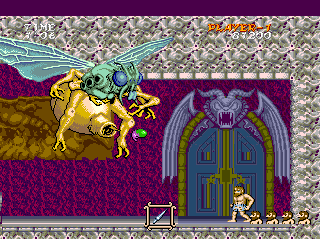
GNG provides us not only with amazing enemies to annihilate but also with remarkable realms to explore. As was the case in Ghouls' predecessor, Ghosts 'N Goblins, the journey commences in a cemetery, one that is now adorned with head-splitting guillotines and patrolled by scythe-wielding reapers. Slay the Statue of Terror and then visit an unfortunate town bursting in gorgeous flames as the earth itself splits and shakes.
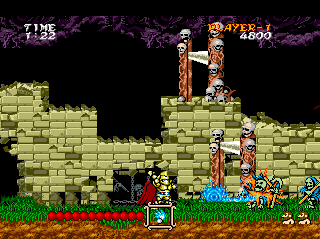
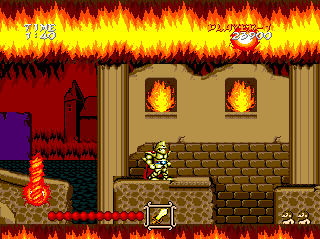
Perhaps the most memorable stage of all is the third, which initially finds Arthur aboard a platform ascending through a dusky tower. Enormous legless knights protrude from the sides of the passage; should you fail to annihilate them before your ride reaches their level, they'll climb onto the platform and inch their way towards you. Watching a gigantic armored villain approach our hero in such ghastly fashion can be a horrifying experience indeed, and the dreary, ominous tune accompanying the action only adds to the scene's intensity.
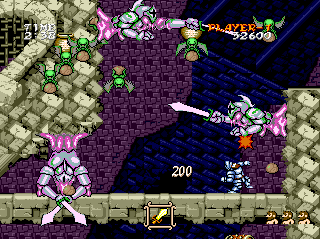
The grimmest, most unsettling scenario comes afterwards, however. Step off that platform and approach the aptly named “Horrible Faced Mountain,” where demonic visages crafted of stone provide you with your sole means of traversing the grounds by sticking out their tongues. Beware of flying horrors and deadly flames, and don’t stay on one “bridge of tongue” for too long, or you'll find yourself gobbled up by a hungry rock beast.

The last level hurls you into a palace that plays host to a ruthless band of demons, dragons, and boss monsters. Most revolting of all are the hellhogs, uncouth villains who won't hesitate to vomit on you should you be caught trifling on platforms below their posts.

Once you conquer the five-board challenge, get set to do it again due to the series' trademark successive-playthroughs requirement for accessing final boss lairs.
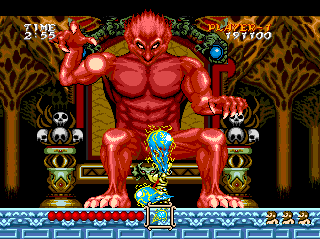
It's all quite brilliant. But whenever I talk about GNG, I feel the need to mention what a kick-ass game its SNES followup, Super Ghouls 'N Ghosts, is. The flaming village is awesome, certainly, but not as memorable for me as the enchanting majesty of Super's snowy forest. And SGNG's wild storm scene, during which Arthur crosses an ocean aboard flimsy rafts, inspires feelings of awe and wonderment that are never evoked by the constantly gloomy GNG. With its dark cemeteries, burning buildings, and demon-faced rock crags, GNG brings about few feelings other than intense, immediate horror: You're in hell, and that's that.
I could delve into details regarding Super's more impressive soundtrack or its greater length, but that would only lead up to the fact that its adventure exudes the "epic" feel far more than GNG's brief five-stage journey. Weaponry is taken to another level in SGNG, with daggers and crossbow shots powering up to veritable lasers and homing missiles. The familiar-feeling controls are aided by the implementation of a double-jump, which might have spared gamers some frustrating moments in this episode.
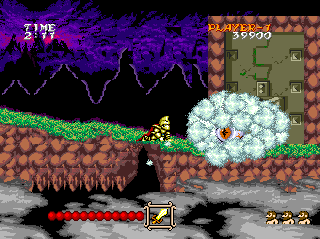
This cloud boss likes to fly around in circles really fast, as if he's trying to perform a "Mode 7" trick so he can star in the super-awesome Super GNG. The poor guy can't quite pull it off.
Not that there's anything shameful about playing shorter, gloomier sister to the beautiful, epic SNES entry. GNG is an excellent game, one that SuperGrafx owners should purchase with no reservations. I just wish we SGX players had been privileged enough to receive a rendition of the Super chapter as well.
